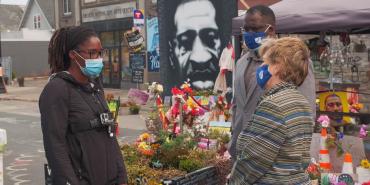Defenders of democracy
Like Sept. 11, 2001, when foreign terrorists permanently changed our lives, the attempt on Jan. 6, 2021, by domestic terrorists, incited by President Donald Trump, to violently overthrow our government and assassinate leaders at the Capitol, will forever change America. Even now, days before President-elect Joe Biden is inaugurated, Trump and his most strident allies are still perpetuating the big lie that the election was stolen, to sow distrust and undermine our democracy. As this new chapter in our history is unfolding, America’s teachers are helping students examine in real time these dangerous and disturbing events.
Adrian Reyna, an eighth-grade U.S. history teacher in San Antonio, had planned a lesson contrasting the 1918 flu pandemic and the coronavirus pandemic. But when his students entered class after the Jan. 6 siege, Reyna shifted gears to discuss the events at the Capitol. Because of the pandemic, he had to do this both online and in person, focusing first on “the human part of what we do in school,” checking to see how students were feeling. Then, mindful of the initial confusion and chaos during events like 9/11, Reyna reminded his students to “make sure we’re working with facts and correct information.”
The class had just studied the Supreme Court ruling that speech creating a “clear and present danger” (such as “falsely shouting ‘fire’ in a theater,” as Oliver Wendell Holmes famously wrote) was not protected by the First Amendment. Reyna assigned students homework: Watch a 13-minute clip of Trump’s remarks at the rally before the riot at the Capitol, then consider whether the First Amendment protects his speech or if he should somehow be held accountable for it.
For Stephen Lazar’s students, the insurrection was a personal affront. “What they saw more than anything else was white privilege,” said Lazar, who teaches a U.S. history and English humanities course to 11th-graders at Harvest Collegiate High School in New York. “They felt deeply the double standard of policing of protest, many of them having experienced the threat of riot police when marching through New York’s streets in Black Lives Matters protests last spring and summer.”
When Lazar opened the discussion on Jan. 7, “It was the horror of the inaction of the police that students wanted to talk about, so we did,” he said. “But then I showed them the speeches of senators—Democrats and Republicans—berating the insurgents and putting forth a vision of an America that perhaps never was, but one day could, and I choose to believe will, be.”
Sarah Lerner knew that the images of armed rioters could be triggering for her students. Lerner teaches English and journalism at Marjory Stoneman Douglas High School in Parkland, Fla., where 17 students and faculty members died in a shooting massacre nearly three years ago. “We understand what it’s like to be running, hiding, not knowing who’s out there or if I am next,” she said.
The day after the storming of the Capitol, Lerner brought it up in her classes, sensitive to how students might be feeling. “I let them know that I’m here to talk or listen or refer them to someone if I can’t help them.” They thanked her, but most wanted to get on with the lesson. Lerner is the adviser for the school yearbook. She talked to her editors the day after the siege. They didn’t want to get “too heavy,” Lerner said, but the yearbook will cover the insurrection, because, like every year, “it’s a time capsule of the year.”
Sari Beth Rosenberg teaches 11th-grade social studies and U.S. history at the High School for Environmental Studies in New York. Once her students processed their reactions—from lack of surprise to outrage—Rosenberg made sure they understood basic facts. “The certification of Electoral College votes isn’t on most Americans’ minds, and definitely not most kids’ minds,” she said. She wanted her students to know why protesters, many of whom became insurrectionists, were in Washington, what Congress’ duty was, and that, despite the storming of the Capitol and some members of Congress baselessly seeking to decertify votes, democracy worked.
“A lot of kids are getting their news on TikTok and Instagram, some of it good, some of it bad,” Rosenberg said. Teachers need to fill in the gaps and help students discern facts from falsehoods, she continued, adding that she is especially concerned about the spread of debunked conspiracies.
“Events are constantly changing,” Rosenberg said. “Our students are looking to us.”
American democracy itself is at stake. Bad actors are waging a war on truth, trampling the rule of law and stoking America’s divisions in order to exploit them. As unconscionable as that is, I take comfort in knowing that America’s teachers are guiding young people to think critically, to discern fact from fiction, to appreciate diversity and respect differences, and to develop the muscle to be engaged citizens. Thank you, America’s educators.

